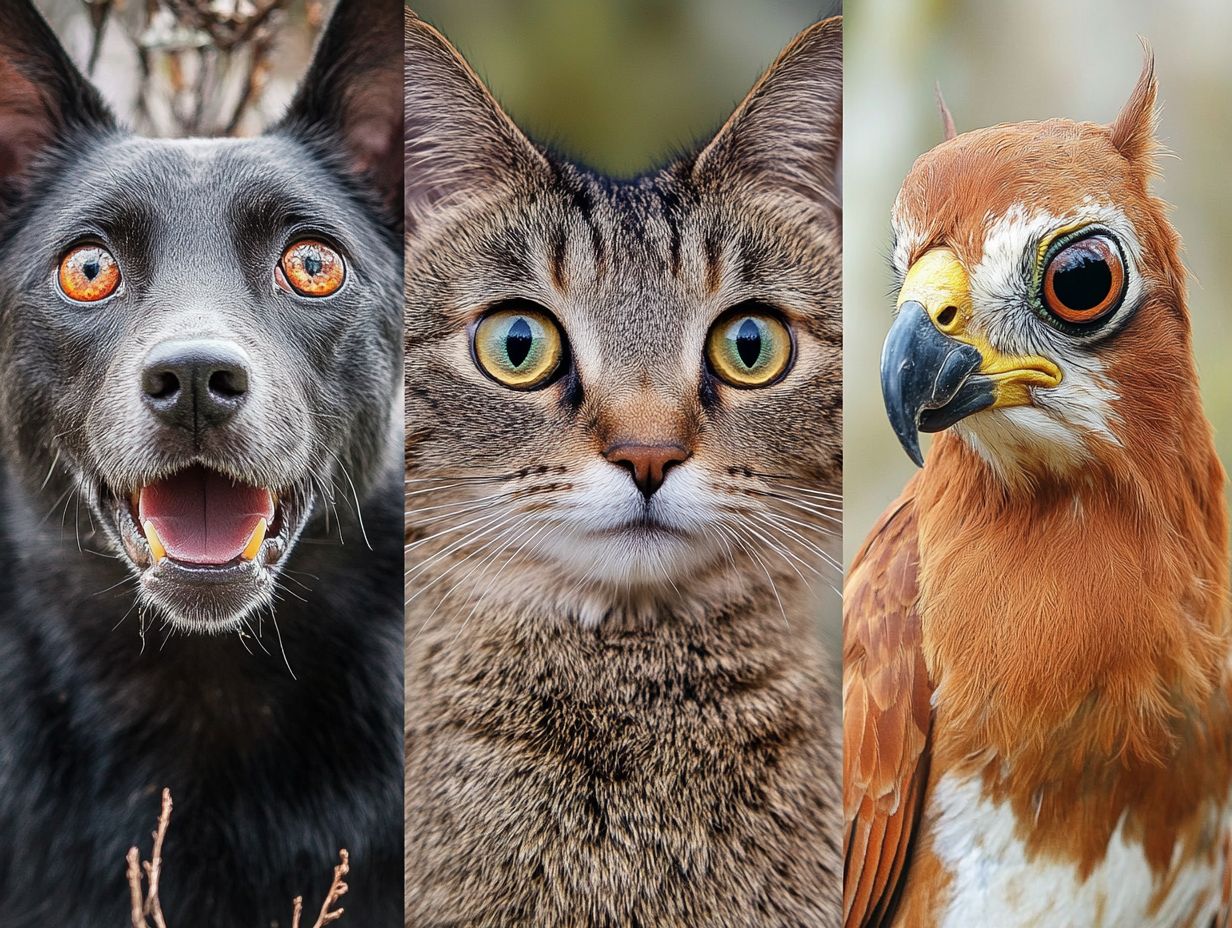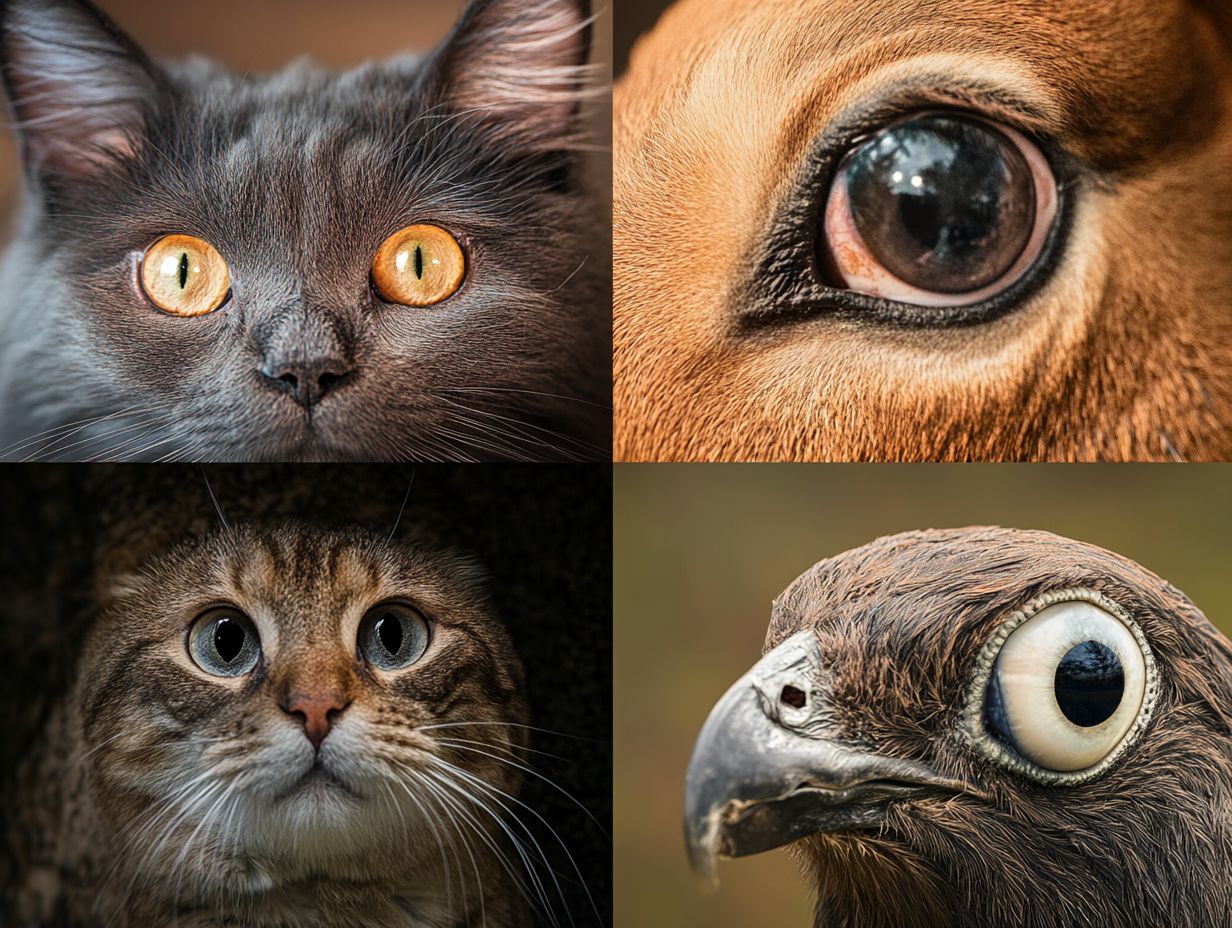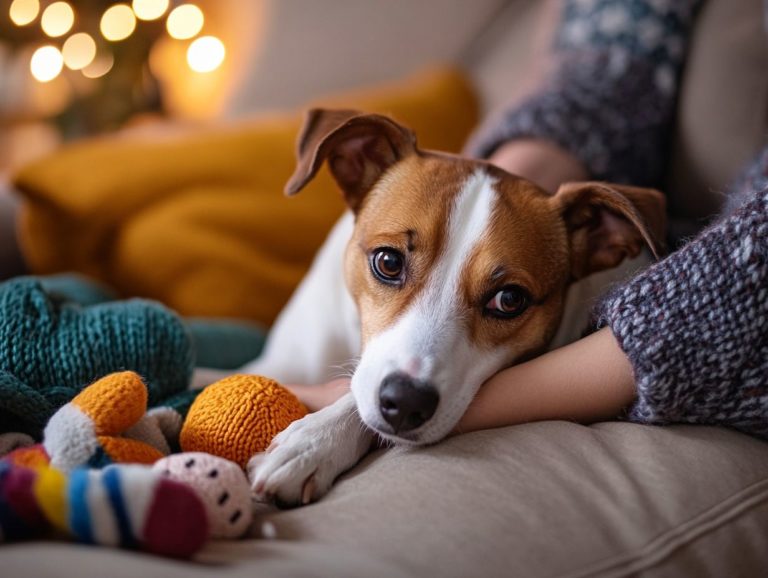How to Recognize Anxiety in Different Species?
Anxiety isn t solely a human experience; it permeates the lives of various animals as well. By understanding anxiety across different species, you can become adept at recognizing its signs and symptoms, which often reveal themselves in both physical and behavioral manners.
This exploration delves into the causes of anxiety in animals, focusing on both environmental and genetic factors that contribute to it. It also covers effective diagnostic methods, treatment options, and strategies for cultivating a stress-free environment for your pets.
By enhancing your understanding of anxiety in our furry and feathered companions, you can play a crucial role in improving their overall well-being.
Contents
- Key Takeaways:
- Anxiety in Animals
- Signs and Symptoms of Anxiety
- Causes of Anxiety in Animals
- Diagnosing Anxiety in Animals
- Treating Anxiety in Animals
- Preventing Anxiety in Animals
- Frequently Asked Questions
- What is anxiety and how does it manifest in different species?
- Can animals experience anxiety like humans do?
- What are some common signs of anxiety in dogs and other animals?
- How can I tell if my cat is suffering from anxiety or other mental health conditions?
- Are there any specific breeds or species that are more prone to anxiety, such as dogs and cats?
- What are some ways to help alleviate anxiety in animals, including coping strategies?
Key Takeaways:

- Recognize anxiety in animals to improve their well-being.
- Watch for physical and behavioral indicators as key signs of anxiety in animals.
- Create a stress-free environment and explore treatment options to manage and prevent anxiety in different species.
Anxiety in Animals
Anxiety in animals, such as dogs, cats, elephants, and chimpanzees, is a complex issue. Recognizing these signs of emotional distress is essential for ensuring timely intervention. To learn more about identifying these signs and providing support, check out this guide on how to recognize and address anxiety in pets. These signs can manifest in both behavioral and emotional distress signals, much like the anxiety disorders seen in humans.
By diving into the emotional capacities of these animals, you gain valuable insights into their experiences and how they engage with their surroundings.
Just like humans, animals can experience panic attacks (sudden feelings of fear), lingering worries, and avoidance behaviors. Understanding these issues, including anxiety triggers in pets, can significantly impact their daily lives and overall well-being.
Understanding Anxiety in Different Species
Understanding anxiety across different species is essential, as it sheds light on how anxiety disorders manifest in a range of animals, including your beloved dogs and cats. To recognize specific issues, it’s important to know the signs of chronic anxiety in pets as well as larger creatures like elephants and chimpanzees.
By examining specific anxiety symptoms like avoidance behaviors and excessive vocalization, you can appreciate the unique coping mechanisms these animals employ. For instance, behavioral tests such as the elevated plus maze (a test used to assess anxiety in animals) or open field test reveal that small mammals, particularly rodents, display heightened stress responses due to environmental stressors like predators or habitat changes. Understanding these behaviors can be enhanced by exploring the anxiety spectrum in pets.
In contrast, elephants, known for their deep social bonds, may show visible signs of distress when separated from their family groups. Grasping these variations not only enhances your understanding of animal behavior but also informs welfare practices that aim to reduce anxiety in diverse settings.
Signs and Symptoms of Anxiety
The signs and symptoms of anxiety in animals can manifest in various ways, from subtle behavioral shifts to more noticeable physical health concerns. As a pet owner, learning how to recognize anxiety in older pets early can make a big difference in your pet’s happiness.
Being attentive to your pet’s well-being will ensure they receive the care they need.
Physical and Behavioral Indicators
Physical and behavioral indicators of anxiety in animals include trembling, excessive barking, and avoidance behaviors. It’s important to look for signs like hyperventilation and pacing, as well as understanding how to spot anxiety symptoms in small pets, which are crucial cues to observe.
These animals might withdraw from social interactions or experience panic attacks during stressful situations, like thunderstorms or loud noises. Recognizing these symptoms is essential; early intervention can significantly alleviate their distress.
By staying attuned to changes in their daily routines and overall demeanor, you can create a supportive environment that nurtures their well-being and reduces anxiety-triggering episodes.
Causes of Anxiety in Animals

The causes of anxiety in animals can be quite complex. These can include various factors, such as environment and related mental conditions.
Certain hereditary traits can make specific species more susceptible to developing anxiety disorders. This multifaceted nature provides insight into the underlying health issues that may lead to specific phobias.
In contrast, elephants, known for their deep social bonds, may show visible signs of distress when separated from their family groups, illustrating the concept of separation anxiety.
Environmental and Genetic Factors
Environmental and genetic factors significantly shape the development of anxiety disorders in animals. These factors influence their responses to stressors and interactions with their surroundings.
For example, an animal raised in a chaotic or unpredictable environment is likely to display heightened anxiety symptoms compared to one nurtured in a stable setting.
Certain traits, like increased sensitivity to noise or unfamiliar situations, can be inherited. You’ll often notice that different breeds exhibit distinct behavioral patterns.
Understanding how these factors intertwine helps you recognize manifestations of anxiety in animals. This knowledge enables you to guide caregivers and veterinarians toward effective intervention strategies for anxious behaviors in pets.
Diagnosing Anxiety in Animals
Diagnosing anxiety in animals demands a thorough approach. This includes integrating observations of how animals behave and veterinary evaluations to accurately pinpoint anxiety disorders in pets.
This comprehensive strategy enables you to deliver tailored treatment options that truly address your pet’s needs. Early action is vital!
Methods and Tools Used
Various methods and diagnostic tools come into play when diagnosing anxiety disorders in animals. If you’re wondering is it normal for pets to have anxiety, these can include behavioral tests, questionnaires, and clinical evaluations by veterinary professionals.
These approaches often begin with meticulous observation, where trained individuals carefully note your pet s responses to different stimuli in their environment. This might involve assessing body language, the sounds they make, and overall behavioral patterns during specific situations.
As an owner, you have a vital role in this process. By providing detailed questionnaires, you can highlight your pet s daily behaviors, social interactions, and any triggers that seem to spark anxiety.
Blending the insights from these observations with your reports helps specialists make a precise diagnosis. This enables them to establish more accurate treatment plans tailored to your pet’s needs.
Treating Anxiety in Animals
Addressing anxiety in animals requires a comprehensive approach. This includes therapeutic interventions, engaging them in gentle exercises, and interactive play.
This not only strengthens your bond but also offers essential emotional support for their emotional well-being. Employing effective coping strategies can alleviate the anxiety levels of your pets.
Effective Treatment Options

Effective treatment options for anxiety in your pets may encompass behavioral therapy, medication, and various anxiety management techniques tailored specifically to their individual needs. These strategies can significantly improve the quality of life for anxious pets.
One approach is a type of therapy that helps change how your pet reacts to stress. Environmental modifications like creating a serene space or utilizing natural scents that help to relax pets can significantly alleviate anxiety levels. It’s essential to understand that each animal is unique; what works wonders for one may not be suitable for another.
Explore different methods to find what works best for your pet. By doing so, you empower yourself to develop personalized solutions that enhance your furry companion’s well-being and foster a more harmonious living environment.
Preventing Anxiety in Animals
Preventing anxiety in animals is crucial for their overall well-being. You can achieve this by cultivating a stress-free environment and employing effective coping strategies and tailored training techniques.
Creating a Stress-Free Environment
Transform your home into a haven for your pets! Creating a stress-free environment begins with a deep understanding of their needs, coupled with emotional support and effective anxiety management strategies. By staying attuned to changes in their daily activities and overall demeanor, you can nurture their well-being and reduce anxiety-triggering episodes.
Start by assessing the living space to ensure it s free from loud noises and harsh lights that could overwhelm your sensitive companions. Incorporating natural elements, like plants or soft furnishings, can help cultivate a soothing atmosphere. Establishing a consistent routine for meals, walks, and playtime provides your pets with a sense of security and predictability, easing any feelings of anxiety.
Engage them in gentle exercises and interactive play; this not only strengthens your bond but also offers essential mental stimulation for their emotional well-being. By thoughtfully considering these factors, you can create an environment where your furry friends feel safe, supported, and truly at ease.
Frequently Asked Questions
What is anxiety and how does it manifest in different species?
Anxiety is a natural response to stress and can be defined as a feeling of unease or worry. It can manifest itself in different ways, such as excessive barking, destructive behavior, or avoidance of certain situations.
Can animals experience anxiety like humans do?

Yes, animals can experience anxiety just like humans. They can feel overwhelmed and stressed by certain situations or environments.
What are some common signs of anxiety in dogs and other animals?
Some common signs of anxiety in dogs include excessive panting, pacing, trembling, and cowering. They may also display destructive behavior, such as chewing on furniture or excessive barking.
How can I tell if my cat is suffering from anxiety or other mental health conditions?
You might notice your cat grooming excessively, hiding, or urinating outside the litter box when anxious. They may also be more vocal and display aggressive behavior.
Are there any specific breeds or species that are more prone to anxiety, such as dogs and cats?
Some breeds of dogs, such as German Shepherds and Border Collies, are known to be more prone to anxiety. However, any species can experience anxiety depending on their individual personality and environment.
What are some ways to help alleviate anxiety in animals, including coping strategies?
Providing a safe and comfortable environment, regular exercise, and positive reinforcement training can help alleviate anxiety in animals. In severe cases, consulting with a veterinarian may also be necessary for medication or other forms of treatment.






